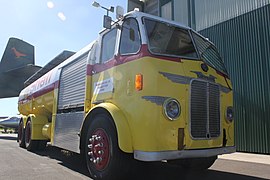Leyland Hippo
| Leyland Hippo | |
|---|---|
 1935 Leyland Hippo | |
| Overview | |
| Manufacturer | Leyland Motors |
| Model years | 1929 - circa 1969 |
| Body and chassis | |
| Layout | 6x4 |
| Powertrain | |
| Engine | Six-cylinder inline Leyland L6 diesel |
The Leyland Hippo was a 6x4 heavy general service cargo truck manufactured by Leyland Motors. Introduced in 1929, it remained in production for 40 years.[1]
First generation
The new 6 wheeled 12 ton capacity goods carrier truck was first demonstrated at the Commercial Motor Transport Exhibition held at Olympia Exhibition Centre in 1929. Introduced as a rigid chassis 6x4 truck, the hippo had the largest engine by Leyland at the time, which was an in line six engines with power output of 72bhp clocking 30mph top speed supported by a four speed gearbox.
As a cab over engine the total length of the unit was 27.3 ft with the wheelbase of 17ft available in tipper and platform model with 19ft loading and 22ft loading space respectively. Having a dry weight of 5 tons.[2] In the 1931 facelift, the total length of the vehicles was changed to 30ft in total with total capacity of 19 tons.[3] In 1934 a new 8 wheeled vehicles was developed on the platform of the hippo called Octopus with same engine but had higher load capacity of 22 tons.[4]
Second generation
In 1945 Leyland developed Mark II Hippo from military programe these units weighed 19tons powered by an in line six engine with power output of 100bhp supported by a five speed gearbox. Civilian versions of the vehicles were to be built with same specifications but with higher load carrying capacity.[5]
At the beginning of World War II the British Armed Forces took delivery of 330 militarized Leyland Hippos with open military cabs and bodies, known in service as the Hippo Mk I or the WSW17. In 1943, as a result of D-Day preparations, Leyland commenced designing an updated version, the Hippo Mk II. Production commenced in 1944 and roughly 1,000 were in service by VE Day. They remained in British service into the 1970s.[6][7]
Gallery
-
Preserved Shell Australia Leyland Hippo fuel tanker
-
Militarised Leyland Hippo Mk I with open cab, 1939
-
Preserved 1952 Leyland Hippo logging truck
-
Preserved Leyland Hippo flatbed
References
- ^ "A rare heavy haulage Leyland Hippo". www.nationaltransportmuseum.org. Retrieved 1 June 2023.
- ^ "A NEW 12-TON SIX-WHEELER | 15th October 1929 | The Commercial Motor Archive". archive.commercialmotor.com. Retrieved 1 June 2023.
- ^ "LEYLAND'S NEW PROGRAMME | 27th October 1931 | The Commercial Motor Archive". archive.commercialmotor.com. Retrieved 1 June 2023.
- ^ "An Eight-wheeler Added to the Leyland Range | 7th December 1934 | The Commercial Motor Archive". archive.commercialmotor.com. Retrieved 1 June 2023.
- ^ "LEYLAND UPHOLDS ITS RE TION WITH HIPPO MARK H | 1st June 1945 | The Commercial Motor Archive". archive.commercialmotor.com. Retrieved 1 June 2023.
- ^ Chris Bishop (ed), The encyclopedia of weapons of World War II, London: Metro Books, 1998, ISBN 1-58663-762-2.
- ^ Pat Ware, A complete directory of military vehicles, Wigston: Anness Publishing Ltd, 2012.
External links
![]() Media related to Leyland Hippo at Wikimedia Commons
Media related to Leyland Hippo at Wikimedia Commons




